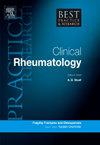Tropical pyomyositis
IF 4.8
2区 医学
Q1 RHEUMATOLOGY
Best Practice & Research in Clinical Rheumatology
Pub Date : 2025-05-01
DOI:10.1016/j.berh.2025.102041
引用次数: 0
Abstract
Tropical pyomyositis is a serious infectious disease characterised by the formation of abscesses in the skeletal muscles and is primarily caused by Staphylococcus aureus, with an increasing incidence in non-tropical regions. The disease primarily affects men and young adults, often following minor trauma, with an increasing incidence in immunocompromised individuals. Immunocompromised hosts are more likely to be affected by Gram-negative organisms, Mycobacterium tuberculosis, opportunistic infections such as fungal pathogens, non-tuberculous mycobacteria, and Nocardia species. Diagnosis is complicated by non-specific symptoms and the low yield of blood cultures, so imaging studies such as Magnetic Resonance Imaging (MRI) are required for accurate identification. Treatment focuses on controlling the source through drainage, tailored antibiotic therapy, and supportive care, especially in patients with complications such as multi-organ dysfunction. Given the complex clinical manifestations, heightened awareness and a collaborative approach to education and resource provision are critical to improving outcomes in patients with tropical pyomyositis.
热带pyomyositis。
热带肌炎是一种严重的传染病,其特征是骨骼肌内形成脓肿,主要由金黄色葡萄球菌引起,在非热带地区发病率越来越高。该病主要影响男性和年轻人,通常在轻微创伤后发生,免疫功能低下的个体发病率增加。免疫功能低下的宿主更容易受到革兰氏阴性菌、结核分枝杆菌、机会性感染(如真菌病原体、非结核分枝杆菌和诺卡菌)的影响。由于非特异性症状和低血培养率,诊断变得复杂,因此需要磁共振成像(MRI)等成像研究来准确识别。治疗的重点是通过引流、量身定制的抗生素治疗和支持性护理来控制源头,特别是对有多器官功能障碍等并发症的患者。鉴于复杂的临床表现,提高认识和合作方式的教育和资源提供是改善患者的结果热带肌炎至关重要。
本文章由计算机程序翻译,如有差异,请以英文原文为准。
求助全文
约1分钟内获得全文
求助全文
来源期刊
CiteScore
9.40
自引率
0.00%
发文量
43
审稿时长
27 days
期刊介绍:
Evidence-based updates of best clinical practice across the spectrum of musculoskeletal conditions.
Best Practice & Research: Clinical Rheumatology keeps the clinician or trainee informed of the latest developments and current recommended practice in the rapidly advancing fields of musculoskeletal conditions and science.
The series provides a continuous update of current clinical practice. It is a topical serial publication that covers the spectrum of musculoskeletal conditions in a 4-year cycle. Each topic-based issue contains around 200 pages of practical, evidence-based review articles, which integrate the results from the latest original research with current clinical practice and thinking to provide a continuous update.
Each issue follows a problem-orientated approach that focuses on the key questions to be addressed, clearly defining what is known and not known. The review articles seek to address the clinical issues of diagnosis, treatment and patient management. Management is described in practical terms so that it can be applied to the individual patient. The serial is aimed at the physician in both practice and training.

 求助内容:
求助内容: 应助结果提醒方式:
应助结果提醒方式:


